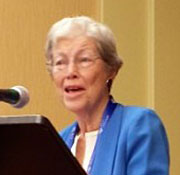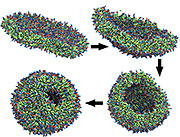Had it not been for an inspiring female chemistry professor in college 70 years ago, Darleane Hoffman may never have gone on to become a widely acclaimed nuclear chemist. Yet if she had followed in that professor’s footsteps, she may also never have gone on to get married and have two children and several grandchildren.
Such were the stark choices facing women in science in the middle of the last century. “At that time, women teachers in the U.S. at all levels were expected to resign if they married, so I proclaimed boldly that I would never teach,” she said. “I vowed to follow Marie Curie’s model, to marry if I wanted and have children if I chose.”
Full Story
Feature
Does your shampoo bottle say “Shake well before using”? Is your shower gel thin and runny? If you answered yes to these questions, you can begin to appreciate the challenges facing the developers of diverse consumer products. Companies need research and development tools that can accelerate the creation of globally competitive products. To that end, consumer-products giant Procter & Gamble (P&G) has turned to DOE's Oak Ridge National Laboratory and America’s fastest supercomputer to simulate microscopic processes that can threaten product performance and stability.
For this Fortune 50 firm founded in 1837, the stakes are high. Procter & Gamble generated than more $85 billion in revenue in 2013 from the global sale of everyday products like lotions, shampoos, toothpaste, and soaps, whose success in competitive markets depends on outstanding product performance. Downy, Head & Shoulders, Olay, and Crest are just some of P&G’s 22 pillar brands each generating more than a $1 billion annually.
Full Story
See also…
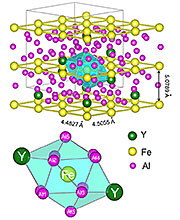 Heat drives classical phase transitions—think solid, liquid, and gas—but much stranger things can happen when the temperature drops. When phase transitions occur at the coldest temperatures imaginable, where quantum mechanics reigns, subtle fluctuations can dramatically transform a material.
Heat drives classical phase transitions—think solid, liquid, and gas—but much stranger things can happen when the temperature drops. When phase transitions occur at the coldest temperatures imaginable, where quantum mechanics reigns, subtle fluctuations can dramatically transform a material. 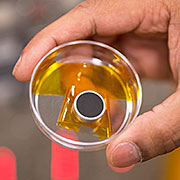 Scientists are a step closer to building an intense electron beam source without a laser. Using the High-Brightness Electron Source Lab at DOE’s Fermi National Accelerator Laboratory, a team led by scientist Luigi Faillace of RadiaBeam Technologies is testing a carbon nanotube cathode — about the size of a nickel — that completely eliminates the need for a room-sized laser system. Tests with the nanotube cathode have produced beam currents a thousand to a million times greater than the one generated with a large, pricey laser system.
Scientists are a step closer to building an intense electron beam source without a laser. Using the High-Brightness Electron Source Lab at DOE’s Fermi National Accelerator Laboratory, a team led by scientist Luigi Faillace of RadiaBeam Technologies is testing a carbon nanotube cathode — about the size of a nickel — that completely eliminates the need for a room-sized laser system. Tests with the nanotube cathode have produced beam currents a thousand to a million times greater than the one generated with a large, pricey laser system.  Researchers at the DOE's Argonne National Laboratory have created a small scale “hydrogen generator” that uses light and a two-dimensional graphene platform to boost production of the hard-to-make element.
Researchers at the DOE's Argonne National Laboratory have created a small scale “hydrogen generator” that uses light and a two-dimensional graphene platform to boost production of the hard-to-make element.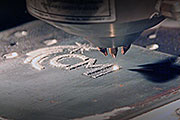 The Critical Materials Institute a DOE Energy Innovation Hub headquartered at Ames Laboratory, celebrated its first anniversary with eleven invention disclosures, all research milestones in a mission to assure the availability of rare earths and other materials critical to clean energy technologies.
The Critical Materials Institute a DOE Energy Innovation Hub headquartered at Ames Laboratory, celebrated its first anniversary with eleven invention disclosures, all research milestones in a mission to assure the availability of rare earths and other materials critical to clean energy technologies.